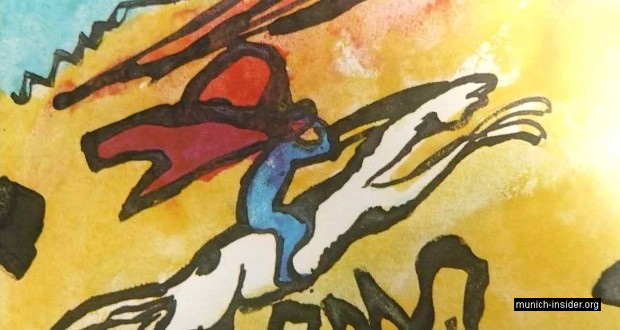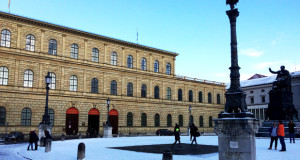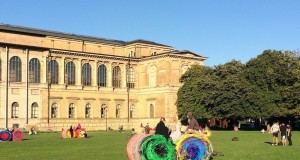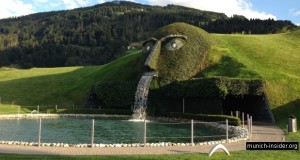Wassily Kandinsky is probably the most revered Russian artist in Germany. It is not just due to the fact that he lived in this country for many years. This master laid the foundations for new directions in art, which afterwards have been actively developed in the German and international art of the 20th century. Kandinsky was one of the founders of abstract painting. In 1911, he together with his associates and students organized in Munich the famous artistic movement, “Der Blaue Reiter” (the Blue Rider).
Later, in the nineteen-twenties he worked and taught at the famous Bauhaus architecture school in Berlin and Weimar. The school became the founder of a revolutionary new direction in architecture. Numerous buildings and entire city blocks were built in the Bauhaus style, mostly in Germany, Russia and Israel. In short, Kandinsky’s contribution to the German art is enormous. Many of his admirers consider the years Kandinsky spent in Munich and its vicinity as the most creative and productive in this life.
Munich to Kochel am See by car: ~70 km, 50 min
Address for GPS navigator: Franz-Marc-Park 8-10, 82431 Kochel am See
Franz Marc museum visit: ~1 hour 30 minutes
Kochel am See to Murnau: ~20 km, 20 min
Address for GPS navigator: Kottmüllerallee 6, 82418 Murnau
Münter-Haus museum visit: ~30 minutes
The Blue Rider
Two events associated with Munich were the most important in Kandinsky’s artistic and personal life. During the time he lived in Munich, a gradual transition from Expressionism to abstract art could be noticed in his paintings. This attracted attention of several German and Russian artists living in Germany at that time. Many were fascinated by these new art directions. These artists united in the group called Der Blaue Reiter (the Blue Rider). Besides Kandinsky, the leading role in the new movement was played by his compatriots Alexej von Jawlensky and Marianne von Werefkin as well as the Germans – Franz Marc, Paul Klee, August Macke, and Gabriele Münter, who all later became famous artists. Gabriele Münter also became Kandinky’s girlfriend and they lived together for several years in the town of Murnau near Munich.
The small house, where the famous artists lived and worked, is now a museum, “Das Münter-Haus.” It is located in Murnau to the south from Munich and is known popularly as the Russenhaus (the Russian House). Not far from Murnau, in the town of Kochel am See there is the Franz Marc museum with an expansive collection of paintings of the Blue Rider group. In general, along with the Munich’s Lenbachhaus Gallery, these two museums display the artistic legacy of Wassily Kandinsky and the Blue Rider movement. To learn more about this period in the life of Kandinsky and his contemporaries, we went for a day trip to these museums in Upper Bavaria.
The Franz Marc Museum
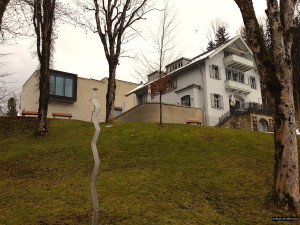 The first stop after less than an hour drive on the number 95 Autobahn was the town of Kochel am See, which is about 70 km from Munich. Franz Marc often spent summers here and painted his famous landscapes, inspired by the surrounding stunning scenery. The museum building is an architectural mixture of different styles: a small villa of the early 20th century and a modern annexe with rectangular shapes and brighter colors.
The first stop after less than an hour drive on the number 95 Autobahn was the town of Kochel am See, which is about 70 km from Munich. Franz Marc often spent summers here and painted his famous landscapes, inspired by the surrounding stunning scenery. The museum building is an architectural mixture of different styles: a small villa of the early 20th century and a modern annexe with rectangular shapes and brighter colors.
Most of the permanent collection consists of Franz Marc’s paintings, but there are also many works of his Expressionist contemporaries. In addition to the permanent collection in the main gallery, the museum organizes temporary exhibitions of artists that were close to Franz Marc, such as Kandinsky and other “Blue Riders”. Unprepared visitor may find the exposition somewhat difficult to understand, so a bit of “homework” in advance would not hurt. At least, one should get acquainted with the terms Post-Impressionism, Expressionism and abstract art. In fact, Kandinsky and his followers developed their manner of painting in that order.
The Franz Marc Museum is open every day except Monday, from 10 am to 5 pm (until 6 pm in the summer). Admission: €8.50. There is the «Blauer Reiter» restaurant at the museum. We liked their menu and a cozy club atmosphere.
Münter-House in Murnau
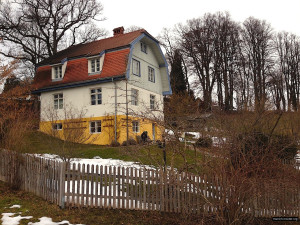 Murnau is just twenty minutes by car from Kochel am See. It is a typical small Bavarian town with cozy houses with hand-painted wooden trimmed facades. The Münter-House or, as it known locally the “Russian House,” is a small house surrounded by lush greenery. Gabriele Münter bought it in 1909 and spent here five happy years with Kandinsky, until the beginning of World War I in 1914.
Murnau is just twenty minutes by car from Kochel am See. It is a typical small Bavarian town with cozy houses with hand-painted wooden trimmed facades. The Münter-House or, as it known locally the “Russian House,” is a small house surrounded by lush greenery. Gabriele Münter bought it in 1909 and spent here five happy years with Kandinsky, until the beginning of World War I in 1914.
The house is now restored to its original condition of the early 20th century. The interior has the character of a country house, in part due to the fact that the artistic couple collected artisan items. The furniture was painted by Kandinsky. The walls are decorated with small paintings and engravings of both artists. Beautiful views of the surrounding landscape can be seen through the windows. Especially impressive are the views of a church and a castle in the mountains. The surrounding scenery likely served as an important source for the painters’ inspiration.
The Münter-House was as a frequent meeting place for the Blue Rider avant-garde. Franz Marc, Jawlensky, Werefkin, August Macke and many other famous Expressionists came here. In short, for over five years the Münter-House was a center of advanced artistic ideas and one-of-a-kind laboratory of new trends in painting. However, this idealistic period was over after the beginning of the World War I, and the artists were scattered in different European countries. Kandinsky, being Russian citizen, was forced to flee to Switzerland. Gabriele Münter had gone with him, but then their paths diverged. Kandinsky returned to Russia and stayed there until 1921 (he came back to Germany eventually). Münter went to Scandinavia, where the two artists met again in 1915, but did not stay together for long. Eventually, their relationship broke down for good. Finally, Münter had returned to Germany and lived in the house in Murnau until her death in 1962. During the Nazi years, she managed to preserve a unique collection of paintings by Kandinsky in the basement of her home. She then gave this collection to the Lenbachhaus Gallery in Munich.
The Münter-Haus in Murnau is open every day except Monday, from 2 pm to 5 pm. Admission: €3.
Share on:
 Munich Insider Tips and advice from Munich residents for self-guided tours and trips
Munich Insider Tips and advice from Munich residents for self-guided tours and trips
